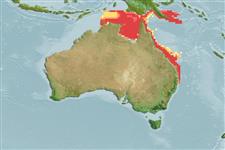Elasmobranchii (sharks and rays) >
Myliobatiformes (Stingrays) >
Dasyatidae (Stingrays) > Urogymninae
Eponymy: Dr James Ramsey Tosh (1872–1917) was a Scottish marine biologist and inland waterway engineer who was employed by the government of Queensland as a fisheries expert (1900– 1903). [...] (Ref. 128868), visit book page.
More on author: Whitley.
Environment: milieu / climate zone / depth range / distribution range
Ecology
Marine; demersal; depth range 10 - 140 m (Ref. 6871). Deep-water; 8°S - 30°S, 130°E - 155°E (Ref. 114953)
Western Pacific: Australia and Papua New Guinea. This species has been misidentified by most ichthyologists as a color form of Himantura uarnak (Ref. 6871). Also Ref. 114953.
Size / Weight / Age
Maturity: Lm ? range ? - ? cm
Max length : 86.0 cm WD male/unsexed; (Ref. 58048)
Demersal on soft bottoms on the continental shelf at depths of 10-140m (Ref.58048). Juveniles (20-22 cm WD) are free swimming. Feeds on prawns, small fishes and crustaceans (Ref. 9840). Ovoviviparous (Ref. 50449). Common by-catch of bottom trawl and beach seine fisheries in the Arafura Sea. Utilized for its meat, skin (high value) and cartilage (Ref.58048).
Life cycle and mating behavior
Maturity | Reproduction | Spawning | Eggs | Fecundity | Larvae
Exhibit ovoviparity (aplacental viviparity), with embryos feeding initially on yolk, then receiving additional nourishment from the mother by indirect absorption of uterine fluid enriched with mucus, fat or protein through specialised structures (Ref. 50449). Distinct pairing with embrace (Ref. 205). Born at 20-22 cm WD (Ref.58048).
Last, P.R. and J.D. Stevens, 1994. Sharks and rays of Australia. CSIRO, Australia. 513 p. (Ref. 6871)
IUCN Red List Status (Ref. 130435: Version 2024-1)
Threat to humans
Harmless
Human uses
Fisheries: minor commercial
Tools
Special reports
Download XML
Internet sources
Estimates based on models
Preferred temperature (Ref.
123201): 25.5 - 28.2, mean 27.2 °C (based on 255 cells).
Phylogenetic diversity index (Ref.
82804): PD
50 = 0.5078 [Uniqueness, from 0.5 = low to 2.0 = high].
Bayesian length-weight: a=0.01023 (0.00486 - 0.02155), b=3.06 (2.87 - 3.25), in cm total length, based on LWR estimates for this (Sub)family-body shape (Ref.
93245).
Trophic level (Ref.
69278): 3.6 ±0.3 se; based on diet studies.
Resilience (Ref.
120179): Low, minimum population doubling time 4.5 - 14 years (Assuming fecundity<100).
Fishing Vulnerability (Ref.
59153): Very high vulnerability (90 of 100).
